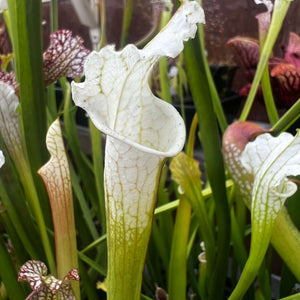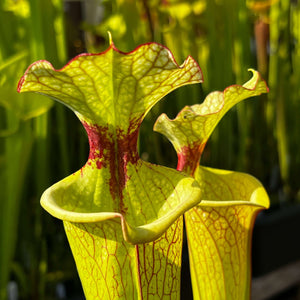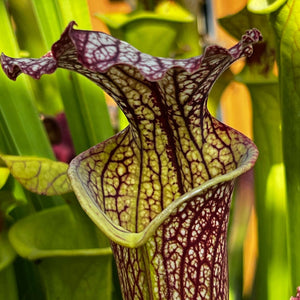Description of Iris ensata 'Crystal Halo'
Iris ensata 'Crystal Halo' is a Japanese Iris that brings a clear colour contrast to the garden. This perennial plant does well in wet soil, making it a good pick for the edges of a pond, a bog garden, or any spot that stays damp.
Plant Size and Flowers
Iris ensata 'Crystal Halo' grows to a height of 90 to 120 centimetres. It spreads to about 45 to 60 centimetres wide. The flowers are large and flat with ruffled edges. Each bloom can be 15 to 20 centimetres across.
The petals show a rich purple colour. A clean white edge frames each petal, creating a two-tone effect. The flower's centre has a bright yellow signal. This adds another layer of contrast. These flowers appear from June to July. They stand on slender stems that hold them up well.
Foliage and Growing Needs
The plant forms clumps of upright leaves. These leaves are sword-shaped and green. They add structure to your garden borders for the whole growing season.
Iris ensata 'Crystal Halo' needs a specific set of conditions to thrive. It likes full sun but will accept partial shade, especially in hotter parts of the country. The most important need is constant moisture.
Soil, Water, and Light
Plant it in rich soil that drains well. Mix in plenty of organic matter like compost. This helps the soil hold water. The plant is suited to wet areas. You can even plant it in shallow water up to 10 centimetres deep.
Keep the soil moist at all times. This is crucial during the growing and flowering season. Avoid dry or very alkaline soils. Full sun will give you the best number of flowers.
This iris is hardy in the UK. It is frost-tolerant and will come back each year.
How to Care for Your Iris
Divide the clumps every three to four years. Do this in late summer or early autumn, after it has finished flowering. Replant the divisions straight away into moist soil. This stops the plant from becoming too crowded and keeps it healthy.
You can also grow it from seed. Sow seeds in autumn or early spring in a damp medium. This method takes more time.
For routine care, water the plant regularly. Apply a mulch once a year. This locks in moisture, stops weeds, and feeds the soil. Cut back the old leaves in late autumn. In early spring, use a balanced, low-nitrogen fertiliser.
Where to Plant It
Use Iris ensata 'Crystal Halo' as a focal point near water. Its elegant flowers and upright leaves work well in water gardens and boggy areas. It is also ideal for naturalising in damp, partly shaded spots like rain gardens.
The flowers are good for cutting. They bring their beautiful form and colour into the home.
Benefits for Wildlife
The flowers provide nectar for bees, butterflies, and other beneficial insects. The dense leaves and roots help to hold soil in place in wet areas. This can reduce erosion.
Key Points to Remember
This iris must have consistent moisture to grow and flower well. Full sun promotes the best display. Remember to divide the clumps every few years to maintain its vigour.

 UK-grown carnivorous plants
UK-grown carnivorous plants





